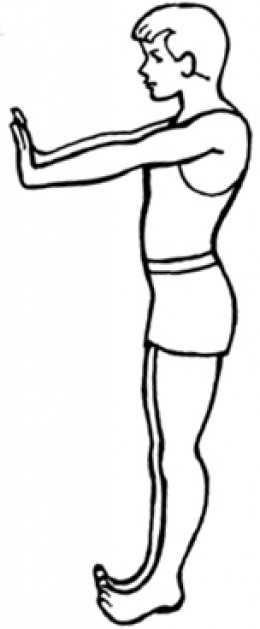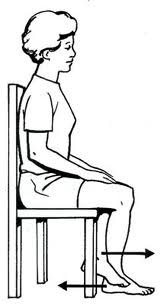How
Effective is Isometrics?
Is
Isometrics better than Isotonics?
Are isometric
exercises a good way to achieve fitness? Or are they more suitable for
building strength? And where to they stand relative to isotonics?
First, let's explain the difference between
the two terms. In an isometric exercise the muscle stays the same length
regardless of the amount of force being used, as, for example, when trying to
lift something that is too heavy to move, or when (as in the picture below) the
muscle is trying to contract but is being prevented from doing so by an
equalizing pressure from another muscle. In an isotonic exercise the
muscle shortens when something is being lifted, as for example, the
raising of the leg in the second picture. The isometric exercise is
generally regarded as more effective for maintaining muscle strength than for
building muscle strength, hence it may be recommended for purposes of
rehabilitation. The isotonic exercise is the one people generally
recognise as being used for fitness, such as playing ball games or
weight-lifting.
|
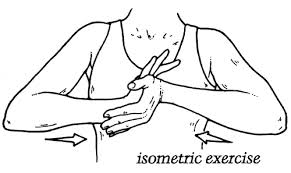 |
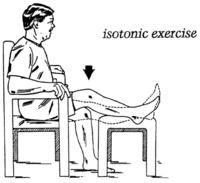 |
|
Muscle is not being shortened |
Muscle being shortened when leg is lifted |
Both forms of muscle contraction
have their benefits. A physical fitness programme ideally would include
both.
40 years ago a book on Isometrics written by
Henry Wittenberg, who had been the United States Olympic team wrestling coach.
promised "Total fitness without effort, using only seconds of motionless
exercise each day." The back cover even suggested, "the next time you are
driving to work, with your right hand pull hard on the steering wheel to the
right; at the same time, with you left hand pull hard on the wheel to your left.
Feel your stomach muscles tighten. You have just exercised -- the easy
way!"
A recent online description of isometric
exercises describes these as
popular among fitness enthusiasts for several reasons. "They can be conveniently
performed any time and anywhere, whether you're at home, in your workplace or
even when you're driving. Another advantage of isometric exercises is that they
can be done without the use of expensive equipment. They are effective for
sculpting and strengthening the body, and they pose very little health threat to
the body."
So one
wonders why a system so simple yet effective, should have enjoyed an enormous
success for a considerable period of time, with all sorts of inventive devices,
such as the "bullworker", being offered to support this activity, and then
be superseded by the alternative (isotonic) exercise that generally is more
expensive and less convenient in terms of cost and location.
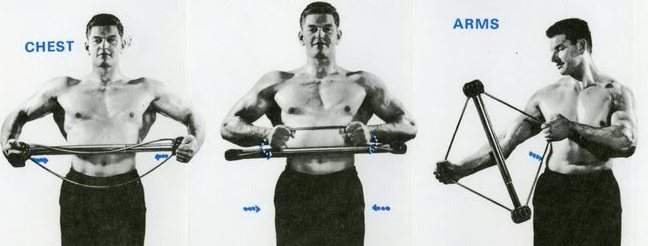
A typical "bullworker" advertisement.
We suspect that this may be due, at least in part, to awareness
of problems that might arise when isometric exercise is practised by people for
whom it might be medically inappropriate, or where alternative - specifically
isotonic - regimens were being recommended by the medical and alternative medicine
professions. One of the most problematic areas in isometrics is their
ability to increase blood pressure dramatically and thus make them
inappropriately dangerous for people suffering from hypertension. Whereas
certain isotonic exercises, particularly those that can be practised easily and
daily - such as walking - would be more beneficial to health.
Let's go through it again, because it really is not
simply a matter of "whether - or", nor is it simply a question of "which is
better?". Both forms of exercise (or - more precisely - contractions) have
benefits; both have potential hazards. As with so much else in life, the
things that are good for us very often contain a corollary if they are not
practised appropriately, as recommended, or to excess.
An isometric contraction is the action of a muscle
or a group of muscles against an immovable object, or against each other,
creating tension without motion. A good illustration of this principle
would be the expression "pulling oneself up by the bootstraps". The most
simple of all isometric exercises is probably the one illustrated above: merely
pressing palms together in front of the chest and maintaining the position for
several seconds. Since the muscles in this exercise are working within
their own limits, there is no risk of injury. On the other hand, because
the results of such isometric contractions are less obvious than those of
isotonic exercises, there may be a tendency for people to over-engage in them.
And as we said above, a potential hazard is provided by anything practised to
excess.
There are two types of isometric exercise. One
utilizes the body's own muscles to exert force on a fixed object, such as a
wall. The other places a muscle in a contracted position for a period of time. A
good example is to have a seat in a chair, extend your legs one at a time and
hold the position for 3-6 seconds. While this type of exercise will not increase
muscle mass as quickly as weight-bearing exercises, it will serve to prevent
muscle and bone loss and increase strength.
Isotonic contractions on the other hand involve
repeating a fixed set of movements while placing strain on a particular muscle.
This occurs, for example, when working out with weights and is most effective at
training large muscles. The results and effects are more speedily and readily
noticeable than those of isometric training. At the same time it is also
much easier to injure oneself by training for too prolonged a time or with
equipment, such as weights, that is too heavy or difficult. Simple
examples of isotonic exercises are push-ups, sit-ups, chest presses and squats.
Most gym exercises are isotonic.
It is easier to recognise excessive isotonic
exercise than excessive isometric exercise. Since isometric exercises do
not involve any movement the body does not provide the same warning signals as
in isotonic exercise, but since the isometric contractions can significantly
increase blood pressure great care should be taken when performing them.
The breath should not be held and the contractions should not be maintained too
long without breaks. It is possible that this potential danger is the
reason why this system of exercising fell into disrepute. This is just
conjecture! But it is supported by the following internet quote
"Regular exercise is typically considered safe
for most individuals, and the benefits usually outweigh the dangers or risks.
But if you and your doctor determine that isometric exercise is dangerous based
on your health history, consider alternatives that include more dynamic or
active movements. Dynamic exercise is a low-resistance movement or workout that
involves repetition and performance. Engaging in a dynamic sport or workout on a
regular basis will increase your endurance, and your doctor may recommend it as
a safe alternative if you have high blood pressure or heart problems. Walking,
swimming, aerobics and elliptical training are a few examples of dynamic
exercise."
On the other hand, the Internet has also provided
the following positive example (although it does conclude with a mild
injunction) from a female "trainer":
"Twice a week, I conduct a
fitness class for seniors at an assisted living group home.
It is my responsibility to find the right combination of
activities to meet the needs of my students. As such, I try
to choose exercises that are fun, safe and easy to perform.
The best exercises that I have found for seniors are
isometric or resistance exercises. This type of exercise can
be done by almost anyone, anywhere; even those seniors who
have limited mobility. No special equipment is required for
isometric exercise. . . Unlike aerobic exercise, which can
cause joint damage through repetitive high-impact motion,
isometric exercises allow the joint to remain static during
the contraction of the muscle. For this reason, isometric
exercises are considered low-impact. Even so, there are
still some risks involved and seniors should take
precautions when engaging in this type of activity."
We have, however, found an
Internet site that describes both the "birth" of the
Isometric Exercise programme, its subsequent "demise", and
it's more recent resurrection. A link to that site is
provided below, but from it we
quote the following:
"The Fall of Isometric Training
"During the 1960's isometric
exercises had gone
mainstream. Athletes such as
Roger Maris, Mickey Mantle,
Bruce Lee and President
Kennedy all used isometric
workouts and extolled their
benefits. In supermarkets
and news stands you could
find all variety of
isometrics. What happened?
"Well, first of all it was a
bit of a fad, I guess. Those
books you could buy where
often written by people who
didn't know the first thing
about isometrics or
isometric contractions. With
titles like "The Lazy Man's
Guide to Physical Fitness"
and "Total Fitness Without
Effort", they all promised
superior benefits with
little to no effort.
Obviously, this is false.
Isometric exercises are easy
to learn. However, they are
NOT easy to do. They do take
work and intense effort. I
suspect a lot of people were
disappointed to learn this.
"Another reason is that
isometric training became
associated with steroid
abuses. Here's what
happened. During the 1950's
the Soviet Unions weight
lifting team started to beat
the American team with
startling regularity. The
coach of the American team
was a man by the name of Bob
Hoffman. He was a self made
man (founder of the York
Barbell company) and
extremely patriotic. It
KILLED him that the Soviets
were beating the pants off
his American squad. He knew
the Soviets were up to
something, but what?
"He sent a doctor friend of
his to investigate. What he
learned was the Soviets were
doing two things
differently. One, they were
training in a German
technique called "Functional
Isometrics". Two, they were
taking steroids. So, what
did Bob do? Rather than call
the Soviets out for their
steroid abuse, he paid his
doctor friend to make BETTER
steroids than the Soviets
had. He didn't even tell the
athletes what he was doing,
telling them they were
getting Vitamin B12
injections. At any rate
before long the American
team started beating the
Soviets. When anyone asked
Hoffman what the change was,
he attributed to a new
system of "Functional
Isometrics" training.
"Steroid use began to spread
throughout the fitness
world. When any bodybuilder
was asked how he achieved
his spectacular gains, he
would follow the example set
by Bob Hoffman. "How have I
improved so much? I'm using
a new system of isometric
training now!" However, as
it always does, the truth
did get out. When it did, a
perfectly fine and valuable
system of exercise, namely
isometrics, became tarred
with the steroid brush.
People thought it had no
value on it's own, which is
a shame as isometric
exercises DO work.
"With time though it seems
to me that people are
re-discovering this form of
exercise. If you are looking
for an exercise system that
will make you stronger as
well as give you a great
look in minimal time
(provided that you work at
it) you might want to give
isometric training a try."
We rest our case!
REFERENCE: http://dnordmark.hubpages.com/hub/isometric-training


